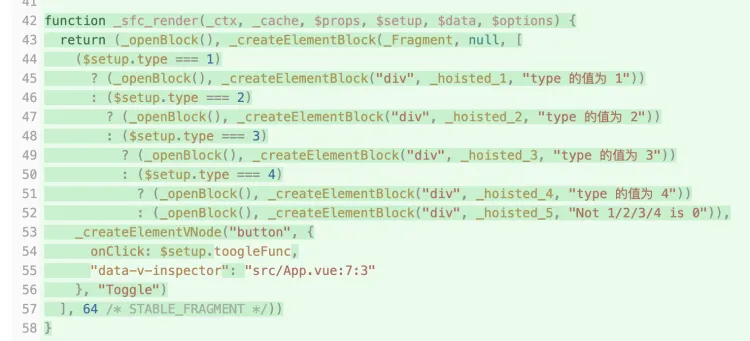目前为止,我们学习过很多 Vue 的内置指令,例如:
- v-if
- v-show5
- v-for
- v-model
- v-html
- v-bind
- v-on
- ……
结合 vite-plugin-inspect 插件的编译结果来进行分析指令的本质。
v-if
<template>
<div v-if="type === 1">type 的值为 1</div>
<div v-else-if="type === 2">type 的值为 2</div>
<div v-else-if="type === 3">type 的值为 3</div>
<div v-else-if="type === 4">type 的值为 4</div>
<div v-else>Not 1/2/3/4 is 0</div>
<button @click="toogleFunc">Toggle</button>
</template>
<script setup>
import { ref } from 'vue'
const type = ref(1)
function toogleFunc() {
type.value = Math.floor(Math.random() * 5)
}
</script>
<style scoped></style>编译结果如下:

对于 v-if 指令,背后对应的就是三目运算符写的不同分支。
每一次 $setup.type 值的变化就会导致渲染函数重新执行,然后进入到不同的分支。
v-for
<template>
<div>
<h2>商品列表</h2>
<ul>
<!-- 使用 v-for 遍历 products 数组,渲染每个商品的信息 -->
<li v-for="(product, index) in products" :key="index">
{{ product.name }} - ${{ product.price }}
</li>
</ul>
</div>
</template>
<script setup>
import { ref } from 'vue'
const products = ref([
{ name: '键盘', price: 99.99 },
{ name: '鼠标', price: 59.99 },
{ name: '显示器', price: 299.99 }
])
</script>
<style scoped></style>编译结果如下:

生成的渲染函数里面,用到了一个名为 renderList 的内部方法。
renderList:packages/runtime-core/src/helpers/renderList.ts
v-bind
<template>
<div v-bind:id>dynamicId</div>
</template>
<script setup>
import { ref } from 'vue'
const id = ref('my-id')
</script>
<style lang="scss" scoped></style>编译后的结果如下:

这里就是将 $setup.id 的值作为 div 的 id 属性值,这里涉及到了响应式数据的读取,因此 $setup.id 的值发生变化的时候,渲染函数会重新执行,div 对应的属性也会发生变化。
v-on
<template>
<div>{{ count }}</div>
<button v-on:click="count++">+1</button>
</template>
<script setup>
import { ref } from 'vue'
const count = ref(0)
</script>
<style lang="scss" scoped></style>编译结果如下:

这个也非常简单,编译结果就是为 button 元素添加上了 click 事件,该事件对应的事件处理函数为:
$event => $setup.count++通过这么几个例子,我们对比编译前后的结果,可以得出一个结论:
最终编译出来的渲染函数,根本不存在什么指令,不同的指令会被编译为不同处理。



